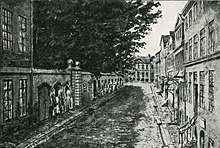Niels Hemmingsens Gade
Niels Hemmingsens Gade is a street in the Old Town of Copenhagen, Denmark. It runs from the western part of Amagertorv in the south to Skindergade in the north and passes Gråbrødretorv on the way. The Church of the Holy Ghost is locatged in the street. The street is named after the 16th-century Lutheran theologian Niels Hemmingsen.
A view down Åbenrå from the northern end of the street | |
| Length | 245 m (804 ft) |
|---|---|
| Location | Indre By, Copenhagen, Denmark |
| Postal code | 1153 |
| Nearest metro station | Gammel Strand |
| Coordinates | 55°40′46.56″N 12°34′37.92″E |
History
.jpg)
The street has existed since the Middle Ages but was formerly known under different names. The street section from Amagertorv to Valkendorfsgade was called Lille Helliggeiststræde (Little Holy Ghost Street) after the adjacent church. It was a very narrow alley. The inclusion of "Little" in the name distinguished it from Store Helliggeiststræde ("Large Holy Ghost Street") as Valkendorfsgade was then called.

The section of present-day Niels Hemmingsens Gade which runs from Gråbrødretorv to Skindergade was called Trompetergangen or Trompetergade after Ambrosius Løffelman, a trumpeter, who owned a property at the site.[1]
The short section from Valkendorfsgade to Gråbrødretorv(Løvgade was called Tugthusporten (Jailhouse Gate) after a Children's jail established at the site by Christian IV but soon moved to Christianshavn (see Women's Prison, Christianshavn.[2] It was a narrow, vaulted passageway which ran through a building. The building had six window bays along the square and two window bays across the street.[3]

Tugthusporten was merged into Lille Helliggeiststræde in 1843 after complains from the residents who found the name unappealing. Trompetergade was renamed Store Helliggeiststræde. In 1881, the entire street was renamed Niels Hemmingsens Stræde to commemorate the theologian Niels Hemmingsen.
The churchyard was originally surrounded by a low wall. It was demolished and replaced by an iron fence in 1797.[4]
Notable buildings
The Church of the Holy Ghost and the House of the Holy Ghost have the address Niels Hemmingsens Gade 5, although both are usually entered through a gate on the corner of Amagertorv with Valkendorffsgade. The House of the Holy Ghost is now used as an exhibition space.
.jpg)
The Women's Building (Kvindernes Bygning) at No. 8–10 was built in 1935 to a Functionalist design by Ragna Grubb. The music venue Jazzhouse is located in the building.
No. 1,3, 15, 23 and 32 all date from the 18th century and are listed.
Bo. 24 (Niels Hemmingsensgade 24 / Løvstræde 7) is a former hospitality school. The building was designed by Vilhelm Klein and H. C. Stilling. The school has now moved to Vigerslev Allé in Valby.
The large building complex at No. 21-21 which continues along Kejsergade and Skindergade was built in 1904–05 to design by Valdemar Ingemann. Ingemann also designed the building at No. 32–34. It is now known as Pressens Hus.
The building at the corner of Løvstræde (No. 24 ( Løvstræde 7) is the former headquarters of Sparekassen for Kjøbenhavn og Omegn.
Public art and memorials

At No. 2, on its centered corner with Amagertorv, between the first and second floors, is a plaque commemorating that Herluf Trolle and Birgitte Gøye owned a property at the site. It mentions that they founded Herlufsholm School on 23 May 1565 and that Trolle died one month later in the house at the site.[5]
The Keystone above the gate to No. 32 features the names Christopher Klog and Anna Jensdatter, Below the stone is a gilded Neptune figure.[6] Klog (1696–1750), a merchant and brewer, was also director of Københavns Brandforsikring,
References
- "Nedlagte gader og stræder". indenforvoldene.dk (in Danish). Archived from the original on 10 May 2016. Retrieved 1 December 2016.
- "Niels Hemmingsens Gade". indenforvoldene.dk (in Danish). Retrieved 1 December 2016.
- "Kjøbenhavn paa Holbergs Tidr". eremit.dk (in Danish). Retrieved 1 December 2016.
- "Lille Helliggejststræde - nu Niels Hemmingsens Gade". Royal Danish Library (in Danish). Retrieved 1 December 2016.
- "Niels Hemmingsensgade 2/Amagertorv 16language=Danish". indenforvoldene.dk. Retrieved 3 December 2016.
- "Niels Hemmingsensgade 32-32a-b". indenforvoldene.dk (in Danish). Retrieved 3 December 2016.
External links
| Wikimedia Commons has media related to Niels Hemmingsens Gade. |
- Niels Hemmingsens Gade at indenforvoldene.dk
- Source